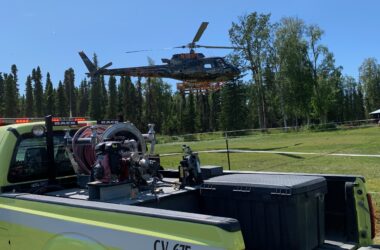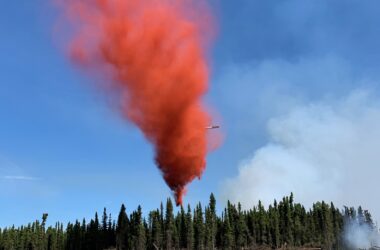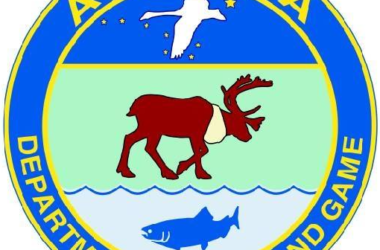The Funny River Fire was a wind driven fire that initially began as a 1.5 to 2 acre fire on the afternoon of Monday, May 19 2014. It began three miles south of the Soldotna airport on the Funny River Horse Trail and after just three hours, the fire spread across 960 acres. It didn’t stop until it reached 195,858 acres, making it the largest wildfire in the country for 2014.
It took four days until there was any containment of the fire line. Thursday morning Incident Commander Rob Allen said the 44,000 acre fire was then 5% contained.

Allen: “The commitment from the Fish & Wildlife is they want to keep this as small as possible and not impact the homes here or the Sterling Highway, so it’s not one of those areas where we’re just going to let it go for resource value. Their direction to me was to put the fire out. And that’s what we’re working on doing [applause].”

A thick plume of smoke kept all eyes on the sky, but with changing wind and weather patterns the smoke descended into a thick haze, making it difficult to breathe and difficult to see the fire.

During the evenings, fire crews began using an infrared drone to monitor the fire’s progress. John Parker with Integrated Robotics says that technology was instrumental in preventing the fire from consuming any primary residences.
Parker: “It was actually the key to the success of fighting that fire. It operating between 11pm and 7am during the fire for 5 days. That time period was called a TFR, a temporary Flight Restriction, where the fire fighters weren’t allowed to fly or work over the fire, because it was too dangerous to do that at night. But the UAV [drone] was used to locate hot spots in the fire and then at 7am in the morning when the fire boss had their first meeting of the day, that data was provided to the fire boss, so they could effectively marshal their resources to the critical areas of the fire.”
One of the most frightening evenings was Friday, May 23. Still early in the fire, residents along Pollard Loop were hastily evacuated in the early morning hours.

We spoke with CES fire fighter Brad Nelson last week about what he learned during those intense few hours…
Nelson: “What it really meant for me was, I got a lesson in what the public would like, whether it was that I have nothing to say right now, because nothing new is going on, or we’ve got this going on, or quelling rumors, what the public really wants as far as information goes. So I got a huge learning curve and lesson on that. This is one of those tools, it was a bad fire, but we didn’t lose any people, we didn’t lose any living structures and good stuff came out of it, so to find the silver lining in that cloud, it was great.”
Nelson deployed last weekend for a tour with the National Guard, but his commitment during the fire was felt by our community; t-shirts with the slogan “Keep Calm and Wait for an Update from Brad Nelson” sold out, bringing in over $2,700 CES’ charity and wildland firefighters.
State Senator Peter Micciche watched as the containment grew and the threat diminished…
Sen. Micciche(R-Soldotna): “It’s a perfect storm of how bad a fire can be. But then you have to couple that with the glass being half full because not a single structure with 123,000 acres today. Is so incredibly improbable that it goes to show that there is somebody looking out for us. You know what I mean?”

With the worst of the threat over, gratitude starting flowing for local businesses, individuals, and the firefighters who spent long hours helping with the emergency.
Tim: “There was no confusion, there was nothing. These men knew exactly what they were doing and they executed it.”
There’s still no official findings on how the fire began, though Federal Wildlife Officer Kelly Modla says because of the timing and location of the fire, they’re confident it was human-caused.
Modla: “Well we’re looking for people and vehicles that may have been in the area, just if they may have information from that day which would be May 19, out at the Wood Cut.”
The state and federal fire fighting efforts ended up costing $8.9 million as crews and equipment were shipped in and out of the area. The bill was largely covered by state and federal grants.
As the crews began to leave, sweet stories of courage and kindness began to surface. During mop up activities, five small puppies were rescued from an abandoned den.

East Coast author Jennifer Keats Curtis was captivated by the story of the pups, Gannett, Hooper, Husila, Stebbins and X-Ray (named after the firefighters’ hometowns and the fire crew who rescued them), who now live in the Minnesota Zoo.
Curtis: “I’ve just been overwhelmed by how voracious this fire was and the fact that this pup was found, it just does seem to be fate because the firefighter had simply stopped to retie his gear while he was on his ATV and there was this little ball of fur and he realized that is was a pup. If he had never seen that animal, I can’t imagine that they would have survived much longer since they were so terrible dehydrated when they were pulled out of the den.”
The Minnesota Zoo reports Stebbins has been asserting himself as the alpha male.
The fire had a significant impact on wildlife in the area, and most of it seems to be positive.

Wildlife Biologist Dan Thompson with the Department of Fish and Game said this summer they’ll be studying how the fire changed moose habitat…
Thompson: “A lot of the summer time habitat is going to be a lot better, and their ability to put fat on over the summer going into the winter will probably be a lot greater. So we’re trying to look at that as well as their habitat use in those areas and that way we can start tying that into future habitat projects to understand what the moose are using in relation to the mosaic from the burn we can start to plan the same type of things for doing a fire mitigation habitat project.”

To read back through KSRM’s complete coverage of last year’s fire, click here. From our News Department and staff, thank you for the courage and selflessness shown during what could have been a tragic time, but will now be remembered as an event which drew our community to strengths never seen before.







